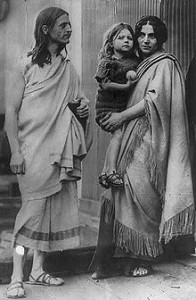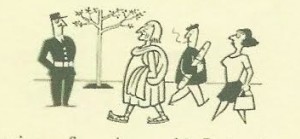Raymond Duncan, Nov 1, 1894 – Aug 14, 1966

Raymond Duncan with his wife and child 1912
For decades, Raymond Duncan wore clothing he spun and wove himself, probably from his own flocks. He was a philosopher, printer, dancer, designer, theater manager as well as spinner, weaver and fabric printer in the Arts and Crafts Movement. He attended literary salons in Paris with Gertrude Stein, gave fashion advice to Isabella Stewart Gardner of Boston, attended post performance parties with Rosalind Russell and created performance clothing for his sister, dancer Isadora Duncan, without succumbing to anyone’s standard of appropriate dress. Raymond believed in fighting the falseness of dress and the falseness of life. He believed in living on what he could make and sell: typefaces, publications, looms, spindles, printed cloth and performances.
Raymond Duncan was born in San Francisco to a prominent family. His mother’s father was a state senator. His father made and lost many fortunes; sometimes the family lived in mansions, sometimes they were almost homeless. All four children were encouraged to be creative. While traveling in Greece, Raymond met and married Penelope Sikelianos, a traditional rug weaver. It was probably her influence combined with his love of Greek antiquities that influenced his style of dress. Raymond and his wife lived for a while in her village, wore hand spun, hand woven chitons and chlamys, cloaks and tunics based on ancient and traditional Greek clothing. They started a weaving school in her village, raised goats and sheep, but also lived in Paris, New York and San Francisco.
I have seen just one of his works, in the Isabella Stewart Gardner Museum in Boston. It is a large cotton plain weave square about 14 inches, with his name boldly printed in black on the bottom. A repeating 9 block pattern evokes the colors and shapes of California hills and trees, browns, olives and golds as if a smaller version of the landscape mural in the de Young Museum’s Piazzoni Murals Room.
It is not easy to track down information about Raymond Duncan’s textiles. Raymond Duncan garnered many mentions in the New Yorker Magazine. EB White wrote a poem, Thoughts on Where to Live in the New Yorker May 4, 1935 that included:
To tend young goats on the Attic hills
And to weave with Raymond Duncan
I’m sure would aggravate my ills
And make me fey and drunken.
In their December 21, 1929 gallery listings they have Raymond Duncan ‘showing his silks at 35 West 57th Street’ his salon / school / dance performance space and probably home. In another New Yorker piece titled Things I Have Never Done, Aug 15, 1931 included ‘never entered a shop conducted by Raymond Duncan.” In the Oct 16, 1948, the New Yorker reporter investigated why an Oshkosh trunk was worth over $5,000 and concluded that it was because the goatskin lining came from Raymond Duncan’s milking herd. The magazine often referred to him as Raymond Duncan, goatherd, rather than artist, philosopher, dancer, publisher, writer or weaver.
In January 1910, The New York Times reported a court hearing on child neglect after his son was picked up by police for being improperly dressed, in sandals and tunic of his father’s design rather than “stockings and knickerbockers and thick-soled shoes.” Sandals worn in a New York winter were viewed as very inappropriate. The court reported the boy was wearing “an outer garment of white wool shaped like a sweater only with short sleeves. It came within an inch or so of the boy’s knees. Beneath it he had a brown woolen jersey of considerable weight, only shorter than the outer garment. Under these he had three heavy linen undershirts of brown and purple. Sandals on his feet completed the lad’s attire. These garments and sandals were probably made by Raymond and his wife, who were reported as wearing similar clothing.
In addition to the short mentions in the New Yorker Magazine, and several articles in the New York Times, there is an obituary in the San Francisco Chronicle and a paragraph in the San Francisco State Textile Show catalog, The Fabric of Life 150 Years of Northern California Fiber Arts History. Syracuse University holds a small Raymond Duncan Collection of 3 folders, but no textiles. Wikipedia includes a family portrait where the clothing is probably his weaving and spinning, but I could not find more photographs of his textiles.
It is as if the current slow clothing and Fibershed movements repeat what Raymond Duncan believed and practiced. We should make what we wear and live by what we make. The value of craft comes from the development of the worker. His reputation as an eccentric combined with his self-promotion and style of dress has helped bury his contributions, but if we met him today at a textile conference, we would greet him as a fellow weaver and spinner and admire his tunic.

The New Yorker 6/13/59
used with permission
1-NewYork Times, January 10, 1910, Page 5
2-The Fabric of Life, 150 Years of Northern California Fabric Art History,San Francisco State University, 1997.
3-Wikipedia.org Raymond Duncan (Nov. 1, 1874 San Francisco, California- August 14, 1966 Cavalaire-sur-Mer, France)